Effect of Low Temperature on Insecticidal Protein Contents of Cotton (Gossypium herbaceum L.) in the Boll Shell and Its Physiological Mechanism
Abstract
1. Introduction
2. Results
2.1. Low-Temperature Effect on the Insecticidal Protein Content of the Boll Shell
2.2. Low Temperature on the Nitrogen Metabolism of the Boll Shell
2.3. Relationship between Boll Shell Bt Protein Content and Nitrogen Metabolism
3. Discussion
3.1. Prolonging the Low-Temperature Stress Treatment Duration Further Reduced the Insecticidal Protein Content and Increased the Threshold Temperature
3.2. The Influence of Low Temperature on Nitrogen Metabolism Resulted in a Decrease in the Contents of Bt Protein
4. Materials and Methods
4.1. Experimental Materials and Design
4.2. Data Collection
4.2.1. The Bt Protein Content
4.2.2. Soluble Protein and Amino Acid Content
4.2.3. Glutamate Oxaloacetate Transaminase and Glutamic Pyruvic Transaminase Assay
4.2.4. Assay of Protease and Peptidase Activity
4.3. Statistical Analysis
5. Conclusions
Author Contributions
Funding
Institutional Review Board Statement
Informed Consent Statement
Data Availability Statement
Conflicts of Interest
References
- Pigott, C.R.; Ellar, D.J. Role of receptors in Bacillus thuringiensis crystal toxin activity. Microbiol. Mol. Biol. Rev. 2007, 71, 255–281. [Google Scholar] [CrossRef] [PubMed]
- Zhang, H.J.; Li, C.Y.; Cheng, L.Y.; Gai, S.P.; Zheng, G.L.; Li, G.X. Bacillus thuringiensis-δ Research progress in mechanism and resistance of endotoxin. J. Northeast Agric. Univ. 2006, 37, 393–397. [Google Scholar] [CrossRef]
- Deguine, J.P.; Ferron, P.; Russell, D. Sustainable pest management for cotton production. A review. Agron. Sustain. Dev. 2008, 28, 113–137. [Google Scholar] [CrossRef]
- Cui, H.Z.; Guo, S.D. Significant progress has been made in the research of insect-resistant transgenic cotton in China. Sci. Agric. Sin. 1996, 29, 93–96. [Google Scholar]
- Clive, J. The development state for commercial Biotechnology and transgenic crops. China Biotechnol. 2012, 32, 1–14. [Google Scholar]
- Cheng, G.X.; Dai, X.F.; Guo, Y.Y. Identification, breeding, utilization and research progress of insect-resistant cotton varieties (lines) in China. Chin. Agric. Sci. Bull. 1996, 12, 18–22. [Google Scholar]
- Luo, Z.; Dong, H.Z.; Li, W.J.; Ming, Z.; Zhu, Y.Q. Individual and combined effects of salinity and waterlogging on Cry1Ac expression and insecticidal efficacy of Bt cotton. Crop Prot. 2008, 27, 1485–1490. [Google Scholar] [CrossRef]
- Qiao, F.B.; Huang, J.K.; Wang, X.B. Fifteen years of Bt cotton in China: Results from household surveys. World Dev. 2017, 98, 351–359. [Google Scholar] [CrossRef]
- Huang, J.k.; Mi, J.W.; Lin, H.; Wang, Z.J.; Chen, R.J.; Hu, R.F.; Scott, R.; Carl, P. A decade of Bt cotton in Chinese field: Assessing direct effects and indirect externalities of Bt cotton adoption in China. Sci. China Life Sci. 2010, 53, 981–991. [Google Scholar] [CrossRef]
- Ali, A.; Desneux, N.; Lu, Y.H.; Liu, B.; Wu, K.M. Characterization of the natural enemy community attacking cotton aphid in the bt cotton ecosystem in northern China. Sci. Rep. 2016, 6, 24273. [Google Scholar] [CrossRef]
- Liu, Z.Y.; Eltayib, H.M.A.A.; Wu, H.M.; Zhou, M.Y.; Zhang, X.; Chen, Y.; Chen, D.H. Bt insecticidal efficacy variation and agronomic regulation in Bt cotton. J. Cotton Res. 2019, 2, 219–224. [Google Scholar] [CrossRef]
- Dong, H.Z.; Li, W.J. Variability of endotoxin expression in bt transgenic cotton. J. Agron. Crop Sci. 2007, 193, 21–29. [Google Scholar] [CrossRef]
- Zhou, M.Y.; Liu, Z.Y.; Li, L.N.; Chen, Y.; Zhang, X.; Chen, Y.; Chen, D.H. Effect of urea spray on boll shell insecticidal protein content in Bt cotton. Front. Plant Sci. 2021, 12, 623504. [Google Scholar] [CrossRef]
- Liu, Z.Y.; Li, Y.Y.; Tambel, L.I.M.; Liu, Y.T.; Dai, Y.Y.; Xu, Z.; Leng, X.H.; Zhang, X.; Chen, D.H.; Chen, Y. Enhancing boll protein synthesis and carbohydrate conversion by application of exogenous amino acid at peak flowering stage increased Bt toxin concentration of boll and lint yield in cotton. J. Integr. Agric. 2022. [Google Scholar] [CrossRef]
- Zhou, M.Y.; Li, Y.B.; Qin, C.; Eltayib, H.M.A.A.; Chen, Y.; Chen, D.H. Square insecticidal protein concentration relate to its biomass in Bt cotton. Agron. J. 2019, 111, 467–472. [Google Scholar] [CrossRef]
- Torres, J.B.; Ruberson, J.R.; Adang, M.J. Expression of Bacillus thuringiensis Cry1Ac protein in cotton plants, acquisition by pests and predators: A tritrophic analysis. Agric. For. Entomol. 2006, 8, 191–202. [Google Scholar] [CrossRef]
- Tambel, L.I.M.; Zhou, M.Y.; Chen, Y.; Zhang, X.; Chen, Y.; Chen, D.H. Amino acids application enhances flowers insecticidal protein content in Bt cotton. J. Cotton Res. 2019, 2, 7. [Google Scholar] [CrossRef]
- Abel, C.A.; Adamczyk, J.J. Relative concentration of Cry1A in maize leaves and cotton bolls with diverse chlorophyll content and corresponding larval development of fall armyworm (Lepidoptera: Noctuidae) and southwestern corn borer (Lepidoptera: Crambidae) on maize whorl leaf profiles. Econ. Entornol. 2004, 97, 1737–1744. [Google Scholar] [CrossRef]
- Zhang, X.; Tian, Q.F.; Zhao, Z.X.; Dong, Z.D.; Chen, Y.; Chen, D.H. Analysis of differentially expressed proteins affecting insecticidal protein content in Bt cotton under high temperature and water deficit stress using label-free quantitation. J. Agron. Crop Sci. 2021, 207, 1–11. [Google Scholar] [CrossRef]
- Chen, Y.; Chen, Y.; Wen, Y.J.; Zhang, X.; Chen, D.H. The Effects of the relative humidity on the insecticidal expression level of Bt Cotton during bolling period under high temperature. Field Crop Res. 2012, 137, 141–147. [Google Scholar] [CrossRef]
- Wang, J.; Chen, Y.; Yao, M.H.; Li, Y.; Wen, Y.J.; Chen, Y.; Zhang, X.; Chen, D.H. The effects of high temperature level on square Bt protein concentration of Bt cotton. J. Integr. Agric. 2015, 14, 1971–1978. [Google Scholar] [CrossRef]
- Lu, X.Y.; Li, S.Y.; Zhu, J.B.; Cheng, F.R.; Liu, F.Z.; Yu, C. Effects of alternating temperatures day and night on cotton bollworm mortality and insecticidal protein expression of two kinds of Bt cottons. Chin. Agric. Sci. Bull. 2015, 31, 103–108. [Google Scholar]
- Liu, Z.Y.; Wang, G.X.; Li, L.N.; Cai, Z.Z.; Liang, P.P.; Wu, X.L.; Zhang, X.; Chen, D.H. Recovery characteristics of Bt insecticidal protein and relative physiological mechanisms after high temperature stress termination in square of Bt cotton. Acta Agron. Sin. 2020, 46, 440–447. [Google Scholar] [CrossRef]
- Chen, Y.; Chen, Y.J.; Chen, Y.; Zhang, X.; Wang, Y.H.; Chen, D.H. The recovery of Bt toxin content after temperature stress termination in transgenic cotton. Span. J. Agric. Res. 2013, 11, 438–446. [Google Scholar] [CrossRef]
- Zhang, X.; Wang, J.; Peng, S.; Chen, Y.; Chen, D.H. Effect of soil water deficit on insecticidal protein expression in boll shells of transgenic Bt cotton and the mechanism. Front. Plant Sci. 2017, 8, 2017. [Google Scholar] [CrossRef] [PubMed]
- Chen, Y.; Wen, Y.J.; Chen, Y.; Cothren, J.T.; Zhang, X.; Wang, Y.H.; Payne, W.A.; Chen, D.H. Effects of extreme air temperature and humidity on the insecticidal expression level of Bt Cotton. J. Integr. Agric. 2012, 11, 1836–1844. [Google Scholar] [CrossRef]
- Chen, D.H.; Ye, G.Y.; Yang, C.Q.; Chen, Y.; Wu, Y.K. The effect of high temperatureon the insecticidal properties of bt cotton. Environ. Exp. Bot. 2005, 53, 333–342. [Google Scholar] [CrossRef]
- Zhang, M.J.; Yang, W.D.; Feng, M.C.; Duan, Y.; Tang, M.M.; Li, X.R. Effects of soil water content and temperature on Bt protein degradation in leaves at thinning stage and buds of Bt cotton. Chin. J. Eco-Agric. 2014, 22, 300–307. [Google Scholar] [CrossRef]
- Shi, J.D.; Li, X.M.; Xin, Y.H.; Zhang, J.B.; Xu, A.L. Effect of cold duration and cold intensity on the germination rate of cotton seeds. Beijing Agric. 2014, 21, 5–6. [Google Scholar] [CrossRef]
- Zhou, X.Y.; Adalaiti, A.; Wang, L.H.; Li, J.; Zhang, J.G.; Liu, M.L.; Lei, B.; Bo, R. Effect of modulators on the growth and physiological characteristics of cotton seedlings during recovery after cold stress. Xinjiang Agric. Sci. 2022, 59, 1060–1067. [Google Scholar] [CrossRef]
- Chen, Y.; Liu, Z.Y.; Dai, Y.Y.; Yue, Y.; Liu, Y.T.; Li, H.J.; He, R.; Zhang, X.; Chen, D.H. Low temperature decreased insecticidal protein contents of cotton and its physiological mechanism. Front. Plant Sci. 2023, 13, 1082926. [Google Scholar] [CrossRef] [PubMed]
- Zhang, X.; Zhou, M.Y.; Li, Y.B.; Liu, Z.Y.; Chen, Y.; Chen, D.H. Nitrogen spraying affects seed Bt toxin concentration and yield in Bt cotton. J. Integr. Agric. 2021, 20, 1229–1238. [Google Scholar] [CrossRef]
- Zhang, L.Y.; Cheng, G.M.; Wei, H.L.; Wang, H.T.; Lu, J.H.; Ma, Z.Y.; Yu, S.X. Response of upland cotton seed germination to low temperature stress and identification of cold tolerance. Sci. Agric. Sin. 2021, 54, 19–33. [Google Scholar] [CrossRef]
- Xia, J.; Hao, X.Z.; Wang, T.G.; Li, H.Q.; Shi, X.J.; Liu, Y.C.; Luo, H.H. Seed priming with gibberellin regulates the germination of cotton seeds under low−temperature conditions. J. Plant Growth Regul. 2022, 42, 319–334. [Google Scholar] [CrossRef]
- Zhou, G.S.; Wang, Y.H.; Zhai, F.Y.; Lu, S.Y.; Nimir, A.E.; Yu, L.L.; Pan, H.; Lv, D.M. Combined stress of low temperature and flooding affects physiological activities and insecticidal protein content in transgenic bt cotton. Crop Pasture Sci. 2015, 66, 740–746. [Google Scholar] [CrossRef]
- Zhang, X.; Wang, G.X.; Lv, C.H.; Liu, X.F.; Chen, Y.; Chen, D.H. The effect of low temperature on the insecticidal properties of bt cotton. J. Food Agric. Environ. 2012, 10, 397–403. [Google Scholar]
- Chen, Y.; Liu, Z.Y.; Heng, L.; Tambel, L.I.M.; Chen, D.H. High plant density increases seed Bt endotoxin content in Bt transgenic cotton. J. Integr. Agric. 2021, 20, 1796–1806. [Google Scholar] [CrossRef]
- Chen, Y.; Liu, Z.Y.; Tambel, L.I.M.; Zhang, X.; Chen, Y.; Chen, D.H. Reduced square Bacillus thuringiensis insecticidal protein content of transgenic cotton under N deficit. J. Integr. Agric. 2021, 20, 100–108. [Google Scholar] [CrossRef]
- Pettigrew, W.T.; Adamczyk, J.J. Nitrogen fertility and planting date effects on lint yield and Cry1Ac (Bt) endotoxin production. Agron. J. 2006, 98, 691–697. [Google Scholar] [CrossRef]
- Chen, Y.; Li, Y.B.; Zhou, M.Y.; Cai, Z.Z.; Tambel, L.I.M.; Zhang, X.; Chen, Y.; Chen, D.H. Nitrogen deficit decreases seed Cry1Ac endotoxin expression in bt transgenic cotton. Plant Physiol. Biochem. 2019, 141, 114–121. [Google Scholar] [CrossRef]
- Chen, Y.; Li, Y.B.; Zhou, M.Y.; Rui, Q.Z.; Cai, Z.Z.; Zhang, X.; Chen, Y.; Chen, D.H. Nitrogen (N) application gradually enhances boll development and decreases boll shell insecticidal protein content in n-deficient cotton. Front. Plant Sci. 2018, 9, 51. [Google Scholar] [CrossRef] [PubMed]
- Dong, Z.Q.; He, Z.P.; Zhai, X.J. The nitrogen metabolized character in leaves of transgenic Bt cotton nucotn 33B and its regulation. Cotton Sci. 2000, 12, 113–117. [Google Scholar]
- Zou, Q. Experimental Guidance of Plant Physiology; China agricultural Press: Beijing, China, 2000; pp. 60–63. [Google Scholar]
- Wu, L.H.; Jiang, S.H.; Tao, Q.N. Colorimetric determination of glutamate oxaloacetate transaminase (GOT) and glutamate pyruvate transaminase (GPT) activity in plants and its application. Chin. J. Soil Sci. 1998, 29, 136–138. [Google Scholar]
- Sun, Y.J.; Sun, Y.Y.; Li, X.Y.; Guo, X.; Ma, J. Relationship of activities of key enzymes involved in nitrogen metabolism with nitrogen utilization in rice under water-nitrogen interaction. Acta Agron. Sin. 2009, 35, 2055–2063. [Google Scholar] [CrossRef]
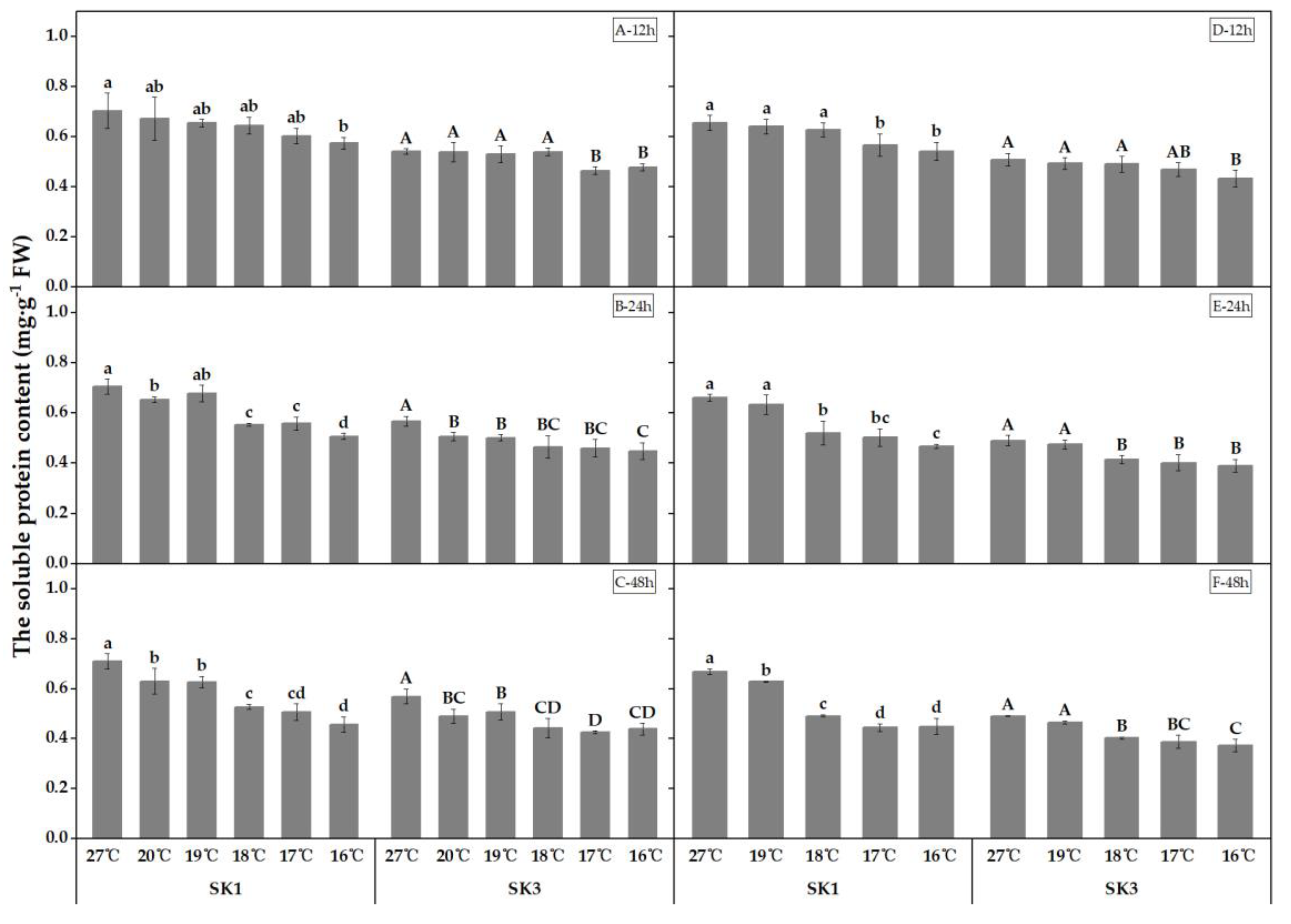
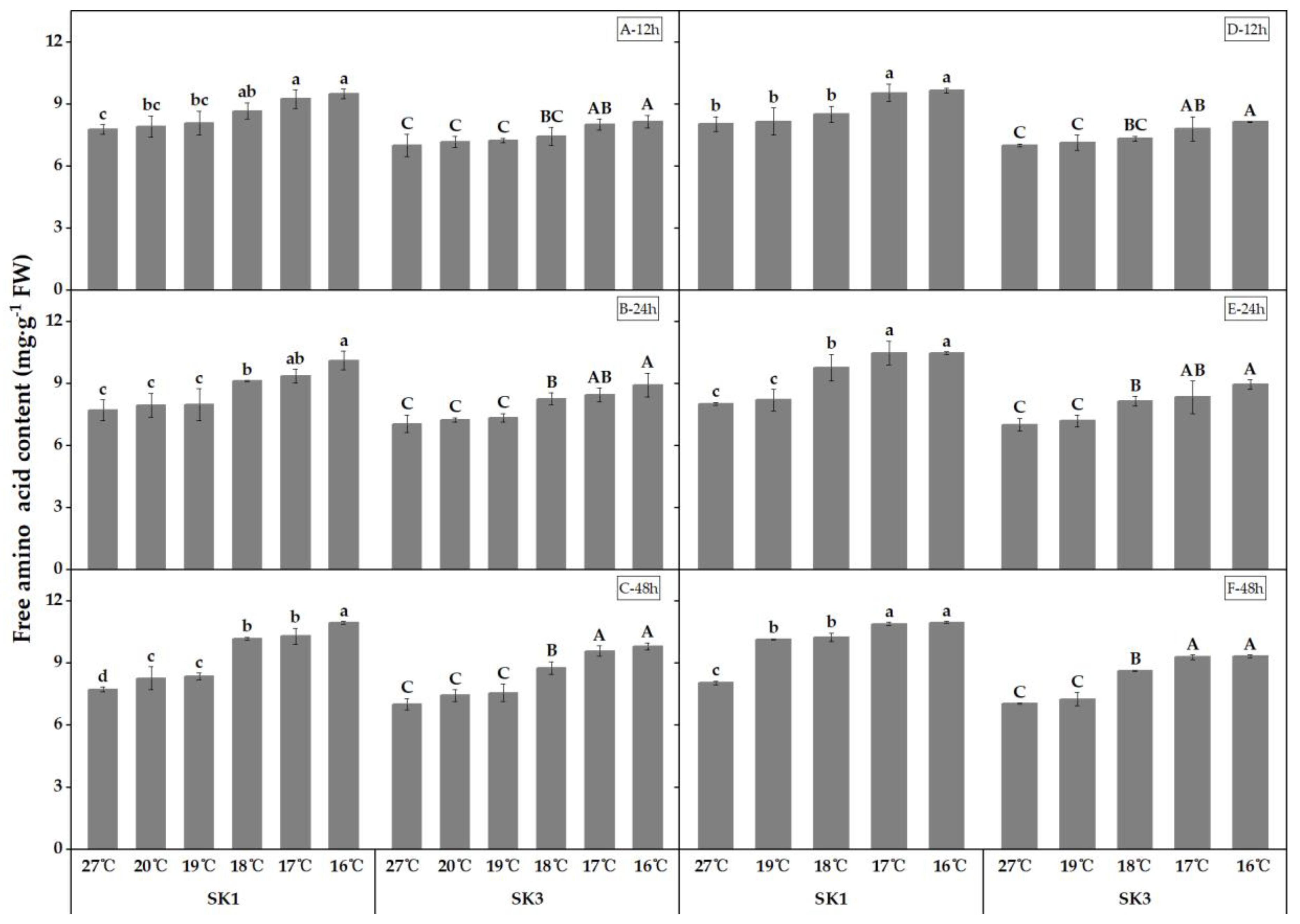

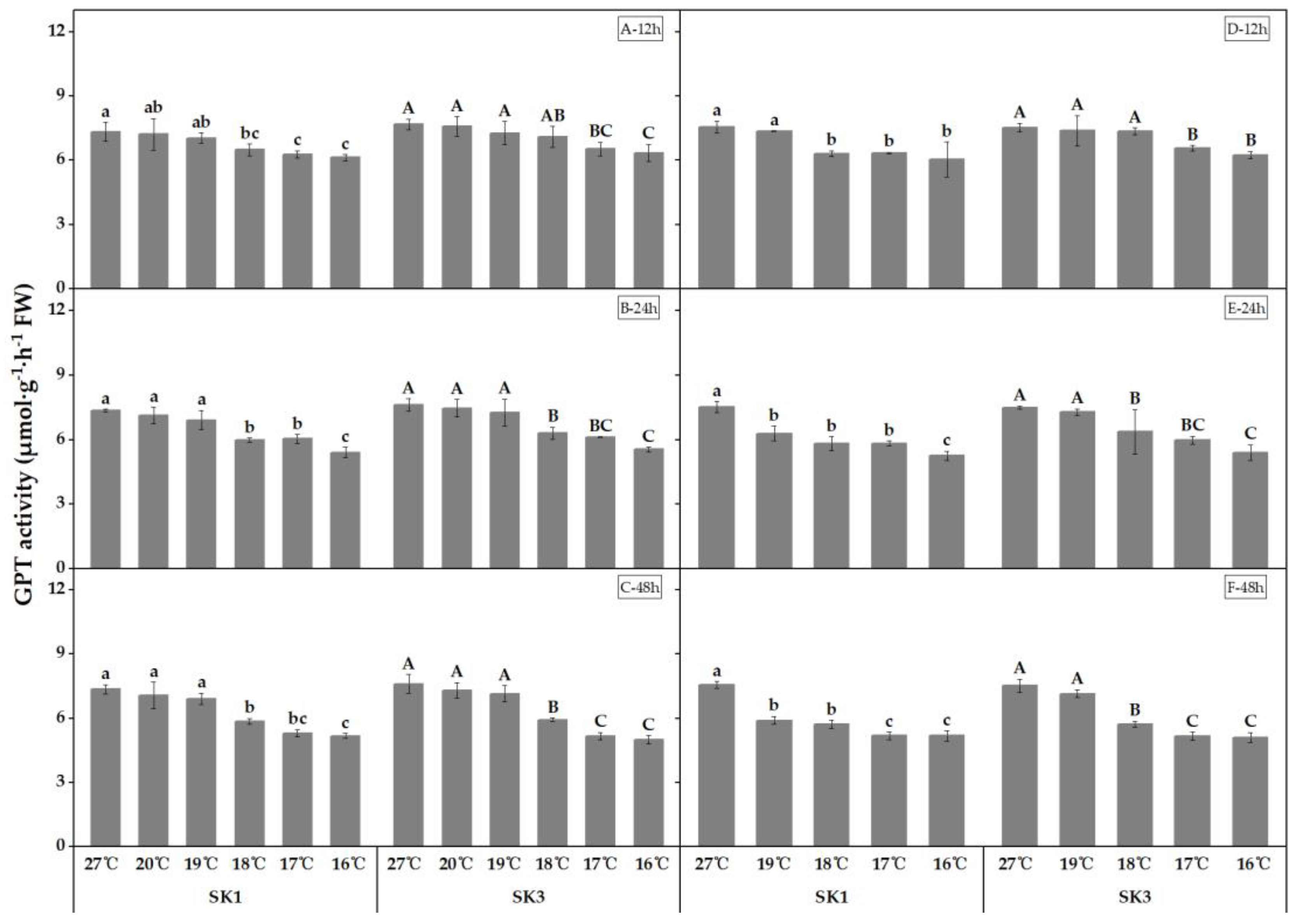


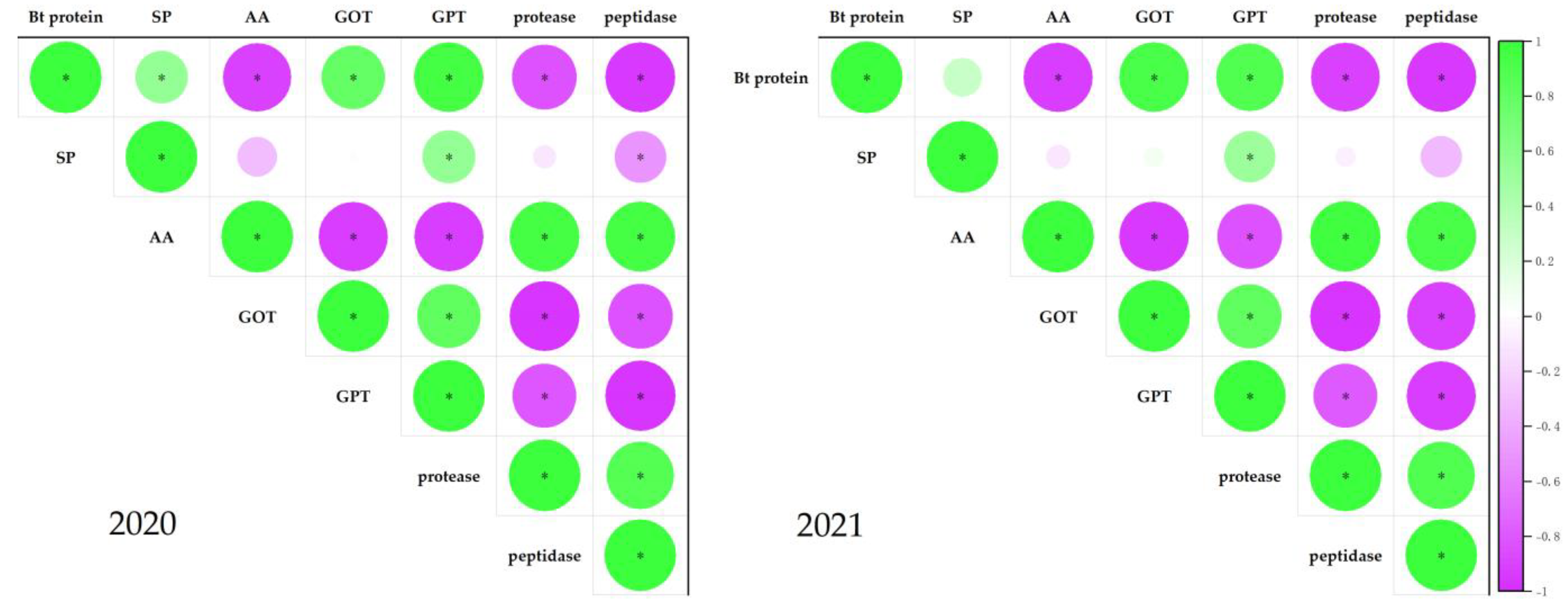
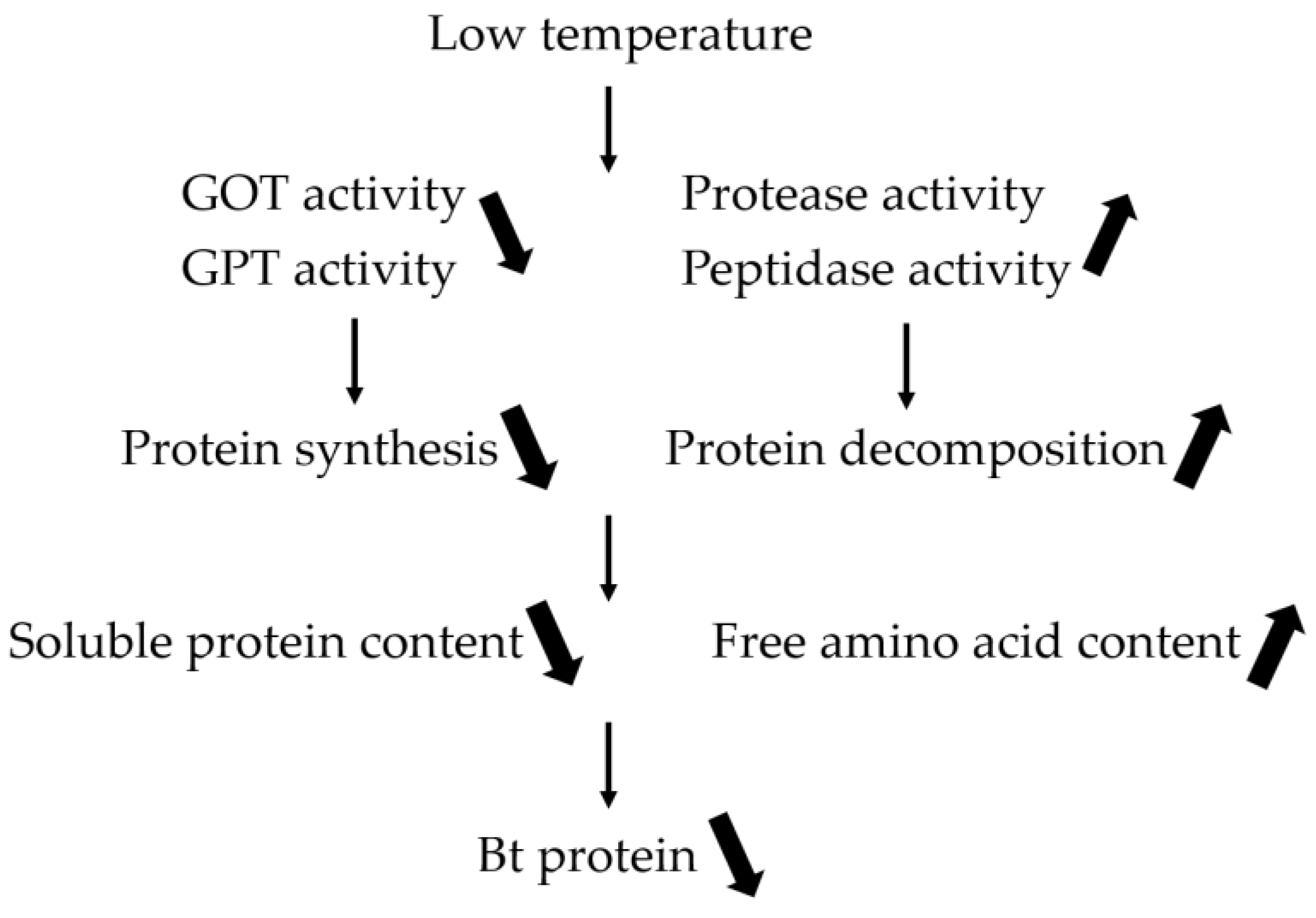
| SK1 | SK3 | ||||||
|---|---|---|---|---|---|---|---|
| Year | Temperature | 12 h | 24 h | 48 h | 12 h | 24 h | 48 h |
| 2020 | 27 °C | 129.68 ± 3.93 a | 130.08 ± 9.98 a | 130.01 ± 3.05 a | 134.60 ± 2.02 A | 134.10 ± 6.96 A | 133.87 ± 2.53 A |
| 20 °C | 128.53 ± 10.04 a | 124.68 ± 7.30 a | 119.97 ± 3.76 b | 133.96 ± 3.70 A | 129.25 ± 8.78 A | 122.73 ± 6.51 B | |
| 19 °C | 128.76 ± 9.73 a | 124.21 ± 1.91 a | 118.88 ± 8.22 b | 133.54 ± 2.10 A | 126.55 ± 2.15 A | 122.87 ± 5.17 B | |
| 18 °C | 128.25 ± 2.93 a | 111.41 ± 3.14 b | 107.16 ± 6.38 c | 129.79 ± 1.42 AB | 112.71 ± 3.01 B | 107.30 ± 2.89 C | |
| 17 °C | 115.18 ± 1.24 b | 109.90 ± 1.44 b | 95.30 ± 3.80 d | 125.12 ± 2.76 B | 111.46 ± 3.74 BC | 97.42 ± 1.97 D | |
| 16 °C | 116.08 ± 3.54 b | 99.08 ± 3.23 c | 94.05 ± 5.72 d | 125.37 ± 3.11 B | 102.46 ± 5.41 C | 96.14 ± 6.13 D | |
| 2021 | 27 °C | 120.43 ± 4.46 a | 120.82 ± 4.18 a | 117.93 ± 3.68 a | 133.10 ± 8.56 A | 132.82 ± 8.69 A | 132.12 ± 8.59 A |
| 19 °C | 118.88 ± 1.14 a | 116.66 ± 8.27 a | 107.88 ± 1.53 b | 132.52 ± 5.20 A | 128.69 ± 4.52 A | 121.17 ± 10.12 A | |
| 18 °C | 118.00 ± 0.73 a | 106.90 ± 2.72 b | 95.74 ± 4.25 c | 130.73 ± 3.54 AB | 119.00 ± 1.00 B | 107.83 ± 0.95 B | |
| 17 °C | 111.76 ± 1.32 b | 102.46 ± 6.52 b | 84.20 ± 0.76 d | 124.68 ± 0.35 B | 113.90 ± 3.20 B | 95.31 ± 2.51 C | |
| 16 °C | 111.35 ± 4.61 b | 90.72 ± 1.18 c | 83.55 ± 2.56 d | 124.44 ± 1.95 B | 101.08 ± 4.29 C | 94.73 ± 2.22 C |
Disclaimer/Publisher’s Note: The statements, opinions and data contained in all publications are solely those of the individual author(s) and contributor(s) and not of MDPI and/or the editor(s). MDPI and/or the editor(s) disclaim responsibility for any injury to people or property resulting from any ideas, methods, instructions or products referred to in the content. |
© 2023 by the authors. Licensee MDPI, Basel, Switzerland. This article is an open access article distributed under the terms and conditions of the Creative Commons Attribution (CC BY) license (https://creativecommons.org/licenses/by/4.0/).
Share and Cite
Liu, Z.; Ji, M.; He, R.; Dai, Y.; Liu, Y.; Mou, N.; Du, J.; Zhang, X.; Chen, D.; Chen, Y. Effect of Low Temperature on Insecticidal Protein Contents of Cotton (Gossypium herbaceum L.) in the Boll Shell and Its Physiological Mechanism. Plants 2023, 12, 1767. https://doi.org/10.3390/plants12091767
Liu Z, Ji M, He R, Dai Y, Liu Y, Mou N, Du J, Zhang X, Chen D, Chen Y. Effect of Low Temperature on Insecticidal Protein Contents of Cotton (Gossypium herbaceum L.) in the Boll Shell and Its Physiological Mechanism. Plants. 2023; 12(9):1767. https://doi.org/10.3390/plants12091767
Chicago/Turabian StyleLiu, Zhenyu, Mingyu Ji, Run He, Yuyang Dai, Yuting Liu, Nana Mou, Jianing Du, Xiang Zhang, Dehua Chen, and Yuan Chen. 2023. "Effect of Low Temperature on Insecticidal Protein Contents of Cotton (Gossypium herbaceum L.) in the Boll Shell and Its Physiological Mechanism" Plants 12, no. 9: 1767. https://doi.org/10.3390/plants12091767
APA StyleLiu, Z., Ji, M., He, R., Dai, Y., Liu, Y., Mou, N., Du, J., Zhang, X., Chen, D., & Chen, Y. (2023). Effect of Low Temperature on Insecticidal Protein Contents of Cotton (Gossypium herbaceum L.) in the Boll Shell and Its Physiological Mechanism. Plants, 12(9), 1767. https://doi.org/10.3390/plants12091767






